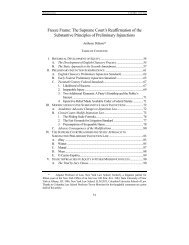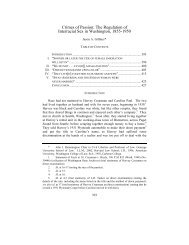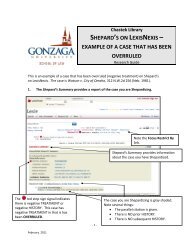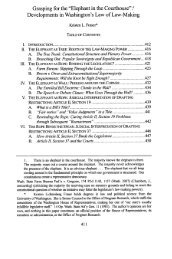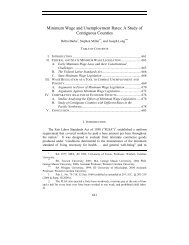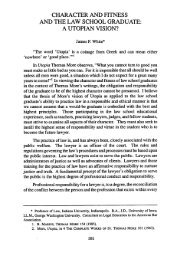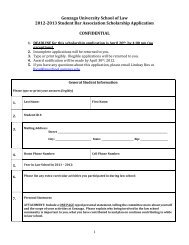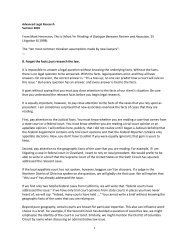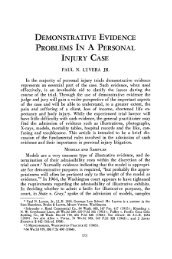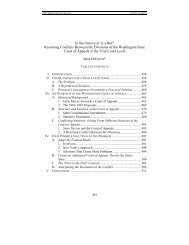professional responsibility, student practice, and the clinical
professional responsibility, student practice, and the clinical
professional responsibility, student practice, and the clinical
You also want an ePaper? Increase the reach of your titles
YUMPU automatically turns print PDFs into web optimized ePapers that Google loves.
1990/91]<br />
STUDENT PRACTICE<br />
for <strong>the</strong> case or a particular task but in reality that <strong>responsibility</strong> has been<br />
assumed by <strong>the</strong> <strong>clinical</strong> teachere 7 , <strong>the</strong>n considerations about disturbing <strong>the</strong><br />
<strong>student</strong>-client relationship will be less important. Communication <strong>and</strong><br />
decision-making take on a markedly personal <strong>and</strong> confidential quality in <strong>the</strong><br />
lawyer-client relationship. 48 A client's confidence in one individual is not<br />
automatically transferrable to ano<strong>the</strong>r. The client is likely to expect that <strong>the</strong><br />
person with whom <strong>the</strong> client has an established primary working relationship<br />
will be <strong>the</strong> person who performs a given task. If that person is <strong>the</strong> <strong>clinical</strong><br />
teacher <strong>and</strong> not <strong>the</strong> <strong>student</strong>, it would be appropriate for <strong>the</strong> teacher to carry<br />
out <strong>the</strong> required lawyering task both from <strong>the</strong> st<strong>and</strong>point of honoring <strong>the</strong><br />
client's legitimate expectations <strong>and</strong> because <strong>the</strong> teacher may be better<br />
informed <strong>and</strong> prepared. On <strong>the</strong> o<strong>the</strong>r h<strong>and</strong>, if <strong>the</strong> primary lawyer-client<br />
relation is with <strong>the</strong> <strong>student</strong>, intervention by <strong>the</strong> teacher could be disruptive.<br />
2. The Client's Informed Consent<br />
The second question, dealing with <strong>the</strong> client's "informed consent,' ' 9<br />
is related to <strong>the</strong> first but goes fur<strong>the</strong>r by requiring <strong>the</strong> <strong>clinical</strong> teacher to<br />
ascertain <strong>the</strong> degree to which <strong>the</strong> client comprehends <strong>and</strong> voluntarily assumes<br />
any risks associated with representation by a <strong>student</strong> ra<strong>the</strong>r than a more<br />
experienced lawyer. Some states <strong>and</strong> <strong>the</strong> ABA model <strong>student</strong> <strong>practice</strong> rule<br />
require <strong>the</strong> written consent of <strong>the</strong> client before a <strong>student</strong> can appear in court<br />
or an administrative tribunal on <strong>the</strong> client's behalf. 5 " Washington's APR 9<br />
representation. It is primary instead of exclusive in <strong>the</strong> sense that <strong>the</strong> <strong>clinical</strong> teacher also<br />
has <strong>professional</strong> <strong>responsibility</strong> for <strong>the</strong> client <strong>and</strong> a duty to adequately supervise <strong>the</strong> work of<br />
<strong>the</strong> <strong>student</strong>.<br />
47. There are a number of reasons why primary <strong>responsibility</strong> for representing a client<br />
can shift from <strong>student</strong> to teacher. Practical reasons include scheduling problems, illness, <strong>and</strong><br />
caseload dem<strong>and</strong>s-in short, <strong>the</strong> same factors which operate in all law offices. Pedagogical<br />
reasons also come into play. These include <strong>the</strong> teacher's assessment of whe<strong>the</strong>r <strong>the</strong><br />
particular case, as it develops, will meet <strong>the</strong> <strong>student</strong>'s need for acquiring certain<br />
competencies. For example, <strong>the</strong> teacher may take over primary <strong>responsibility</strong> for a<br />
guardianship matter because <strong>the</strong> <strong>student</strong> has already demonstrated proficiency in <strong>the</strong><br />
dem<strong>and</strong>s of guardianships <strong>and</strong> needs to be challenged in o<strong>the</strong>r areas.<br />
48. MODEL RULEs OF PROFESSIONAL CONDUCr Rules 1.2, 1.4 <strong>and</strong> 1.6 (1990).<br />
49. Some commentators have argued that <strong>the</strong> doctrine of informed consent, as applied<br />
to medical decision-making, must be applied to legal decision-making. See, e.g., Spiegal,<br />
Lawyering <strong>and</strong> Client Decisionmaking: Informed Consent <strong>and</strong> <strong>the</strong> Legal Profession, 128<br />
U. PA. L. REV. 41 (1979). My argument is that at least <strong>the</strong> creation of <strong>the</strong> lawyer-client<br />
or <strong>student</strong>-client relationships should be accorded <strong>the</strong> values of informed consent.<br />
50. See, e.g., LA. Sup. CT. R. § XX(3); MODEL RULE § II.A.



